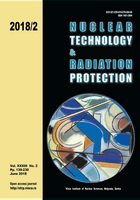
MULTIYEAR INDOOR RADON VARIABILITY IN A FAMILY HOUSE – A CASE STUDY IN SERBIA

Vol.
XXXIII, No. 2, Pp. 139-230
June 2018
UDC 621.039+614.876:504.06
ISSN 1451-3994
Pages: 174-179
Authors: Vladimir I. Udovičić, Dimitrije M. Maletić, Radomir M. Banjanac, Dejan R. Joković, Aleksandar L. Dragić, Nikola B. Veselinović, Jelena Z. Živanović, Mihailo R. Savić,
and Sofija M. ForkapićAbstract
The indoor radon behavior has complex dynamics due to the influence of the large number of different parameters: the state of indoor atmosphere (temperature, pressure, and relative humidity), aerosol concentration, the exchange rate between indoor and outdoor air, construction materials, and living habits. As a result, indoor radon concentration shows variation, with the usual periodicity of one day and one year. It is well-known that seasonal variation of the radon concentration exists. It is particularly interesting to investigate indoor radon variation at the same measuring location and time period, each year, due to estimation of individual annual dose from radon exposure. The long-term indoor radon measurements, in a typical family house in Serbia, were performed. Measurements were taken during 2014, 2015, and 2016, in February and July, each year. The following measuring techniques were used: active and charcoal canisters methods. Analysis of the obtained results, using multivariate analysis methods, is presented.
Key words: radon variability, multivariate regression analysis, multi-seasonal radon
measurements, indoor radon
FULL PAPER IN PDF FORMAT (490 KB)